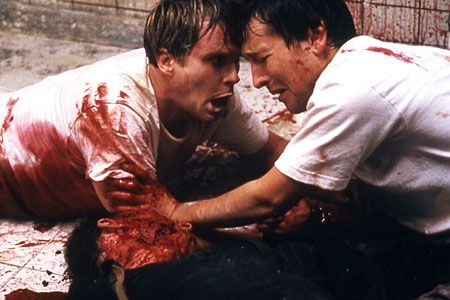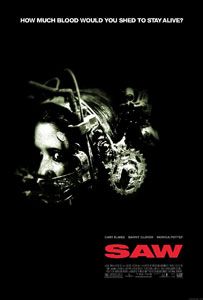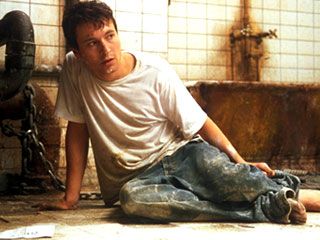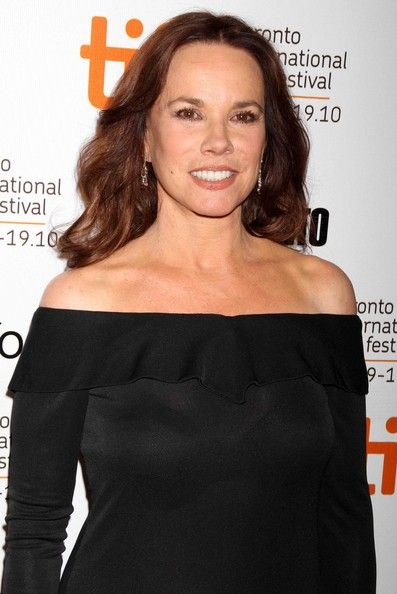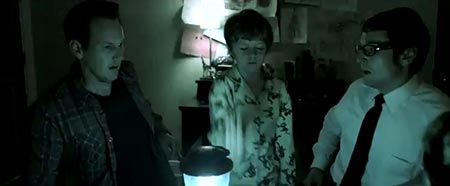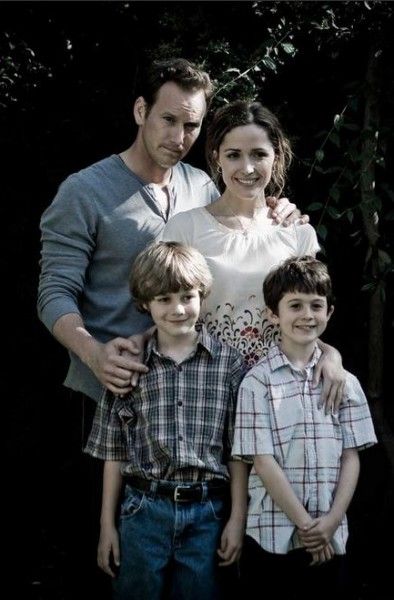Insidious got off to a solid start this weekend. The horror film outperformed expectations of $10 million for an impressive 3rd place at the box office with an estimated $13.5 million. It marks the first big screen pairing in four years of Saw creators James Wan and Leigh Whannell as director and writer and surprisingly just their third feature-length collaboration in those roles. Their latest project follows a young family (Watchmen star Patrick Wilson and Rose Byrne of Damages fame play the parents of two boys) who have just moved into a new home when bizarre events occur that make the mortgage the least frightening aspect of their new purchase. Insidious appears to be a traditional haunted house film until the plot takes a major turn.
Collider caught up with director James Wan and writer Leigh Whannell (who also provides some comic relief onscreen) for a very revealing interview. Hit the jump for the audio and transcript, including: updates on their future projects, a candid take on some high-profile horror remakes and stories of some formerly condescending classmates who have a very different take on their work these days.
The Hollywood success of James Wan and Leigh Whannell reads like one of the town’s inspirational screenplays. It’s a story of two guys living half a globe away from L.A. with dreams of filmmaking but limited connections to realize them. They meet as students at The Royal Melbourne Institute of Technology’s film school with classmates who look down on them for their love of horror films. Just before graduation, a professor even tells their departing class that none of them will succeed.
Inspired by DIY directors like Kevin Smith and Robert Rodriguez and desperate to make their first film, Wan and Whannell sketch out three high concept/low budget ideas to make a mark. They are: two guys trapped in a room with a body, a gun and a tape player (Saw), a man wakes up with mysterious scratches on his body so he videotapes himself sleeping to see how he got them (an idea Jason Blum and Oren Peli also had and made into Paranormal Activity) and the third which would become Insidious (produced by Blum and Peli).
Wan and Whannell seize on the idea of two guys stuck in a room and use about $7,000, mostly from Whannell’s savings, to shoot a nine minute short film taken from a section of the screenplay that would become Saw. After funding proves impossible in Australia, they fly to LA with a screenplay and DVD of the short film, in hand. Their manager back home sets up a bunch of meetings, and while they get some offers to make the film, none of them would allow James to direct or Leigh to co-star. Finally, a company that becomes Twisted Pictures agrees to let them make their film with total creative control… for a tiny budget. Cut to a down-and-dirty 18-day shoot in an abandoned L.A. warehouse. During production, they shack up in an apartment that doubles as an editing suite, so the screams that are cut into the film simultaneously enter their dreams.
In 2004, they submit a freshly edited Saw to the Sundance Film Festival and it shocks already sleep-deprived audiences in the midnight section into several more waking hours once they leave the theater. In a year that showcases breakout festival hits from 1st time feature directors that alter the landscape of their respective genres, including: Super Size Me (documentary) and Napoleon Dynamite (comedy), Saw changes the direction of horror films and makes a boatload of cash ($103 million) for the filmmakers and Lionsgate, who comes onboard just prior to the festival. The run is truly impressive for a project initially made for $700,000.
The film James Wan and Leigh Whannell originally envisioned as a one-off morphs into a franchise with a new installment each Halloween weekend. Saw enters the cultural lexicon, referenced by politicians, pundits and even late night talk show hosts. The 7th and final film concludes the run in late 2010 to cap a combined series gross of more than $870 million, worldwide.
Of course, all that success comes with a backlash. Some critics say Wan and Whannell use gore, not skill, to scare audiences. Their first non-Saw follow-up, Dead Silence doesn’t resonate with critics or at the box office after a well-documented struggle at Universal Pictures. Wan’s next film, Death Sentence (which features Whannell as an actor, not a screenwriter), doesn’t sway many doubters, either.
That doubt is starting to fade, thanks to a return to the pair’s indie roots and a shift in their filmmaking. Like Saw, Wan and Whannell independently produce Insidious on a shoestring budget before it’s bought at a major festival (Toronto). Just as Saw featured three big names (Cary Elwes, Danny Glover and Monica Potter), their latest cast is led by three established stars: Golden Globe nominees Patrick Wilson and Rose Byrne and Oscar nominee Barbara Hershey (whose presence is among several nods to her 1983 supernatural thriller The Entity). However, this is the pair’s first PG-13 rated film and less violence doesn’t mean fewer scares. In fact, they’re getting the best reviews of their careers.
The pair tapped social networks to help promote the film. Wan and Whannell, now both 34 years old, joined Twitter (@creepypuppet and @lwhannell, respectively) and Leigh’s even writing a blog to document the publicity tour with thewordinthestone. We started our conversation with their decision to join the Tweeting masses.
For this particular interview, we strongly recommend you click here to listen to the audio, but you can also read on for the transcript.
-
Leigh Whannell: We finally gave in.
James Wan: Gave in. I gave in sooner than Leigh did, though.
Collider: What was (the reason for) the choice?
Wan: Well, just ‘cause all of my friends are on it and they all tell me to follow them, so I finally did. (Laughs)
Yeah. Well, Saw has such a passionate following of fans. How are you incorporating social networking in terms of your promotion for (Insidious)?
Wan: We think it’s such an important part, you know, of the process these days. You know? Like, marketing has taken such a complete shift, thanks to the internet. So, I think it’s good for the fans, as well, because they get to connect with you directly. You know, in the old days, if I wanted to, like, write to (Steven) Spielberg or Sam Raimi or whatever, I’m not sure I could actually write a fan mail and (I’d) have no idea where to actually send it. Nowadays, you can just, like, follow Ashton (Kutcher who still has among the most followers on Twitter) or, like, friend someone, you know, on Facebook, and you can actually just say, “Hey, I like your stuff.”
Whannell: Yeah, that direct, one-to-one contact is pretty good. We want to cultivate the Saw fans that are out there and talk to them and have a conversation with them.
Wan: And partly because, you know, we’re very appreciative of what they’ve done. For supporting the film and supporting the stuff that Leigh and I have done and the best way to give it back is just, like, talking to them. (Laughs) It’s as simple as that.
Yeah, and speaking of coming back to Saw, I mean, this is like it’s coming back to your roots, with Insidious. The reason why you had two guys in a room (in Saw) is because of budgetary constraints.
Whannell: Yes.
How do we make $5,000 work?
Wan: Right.
So everything kind of flows from there.
Whannell: Right.
Here (with Insidious), you make silence work to scare people. You make things that you don’t need huge effects through the first-
Wan: Right.
-half of the film-
Wan: Right.
-to scare people. And this may sound bizarre, but how freeing are budgetary constraints?
Whannell: They can be really freeing. I mean-
Wan: Well, I mean, yeah, ok, firstly, I want to say that Insidious was made for far less money than the 1st Saw film was. (Pause) So, so we didn’t actually…
Far less than $700,000?
Wan: (Pause) Saw was shot for $700,000. Then, Lionsgate came in and finished it off at about $1,000,000. It’s about the first, initial price ($700,000). That’s what Insidious was made for, right? So, it’s actually less than what the final product of Saw was and so that actually allowed Leigh and I a lot of freedom to make the scare (work) because if we ran this through the studio system, they would say, “Well, if you have a ghost or, or something, that appears in the corner, you have to sting it! You have to sting it with a loud musical cue. But then I would fight that and say, “No, it’s scarier if a character just walks past and we don’t acknowledge it. We don’t acknowledge it in the filmmaking. We don’t have the character acknowledging it by knowing that there’s something there. The audience watching it, all of a sudden, will go, “Did I just see something?” Because you’re not sure, right? And I think that is the kind of layered filmmaking, in this kind of scary movie that adds to it and it just builds and I believe that I would have made a very different film with Insidious if it was channeled through the studio system and that really did free us up.
Whannell: In terms of writing, (it) definitely is freeing to have some budgetary constraints. It’s almost like, if I said to you, “Ok. Write me a five page story about anything in the world.” “Hold on a second,” you’re like, “what am I gonna write a story about?”
Wan: Right.
Whannell: If I tell you, “Give me a five page story about a scuba diver.” All of a sudden, it frees you up. The constrictions that I’ve placed on you, that it has to be about a scuba diver lets you work and I feel that the budgetary constraints-
Wan: Gives you a direction.
Whannell: Yeah, knowing how cheap this film was gonna be, writing the script, I knew I had to tone everything down. Keep the locations low. Keep it in two houses.
Wan: Yeah. I told Leigh, “Write me a scary movie, but we set it only in two houses.” (Laughs) And, that’s the great thing about haunted house movies is, your house is your set for the entire film and uh-
Whannell: But hopefully, it doesn’t really feel like a low-budget film, Insidious.
Wan: Well, that’s the thing, right, about horror.
No, I’m not saying it as an insulting thing. I mean it as-
-as indie films (allow for more) creative control and you’ve talked enough times about Dead Silence and what the studio process was like, but in (Insidious), and knowing you guys a little bit, you’re like, “All right. We’ve got this much to do. This is how we can make it work.
Wan: Uh huh.
And you make it work. And it’s fun and (Leigh), you’ve talked about your influences. Jaws and-
Whannell: Yeah.
-how you don’t see the shark through the first (half) of the film.
Whannell: Yeah.
And also, David Lynch as an influence and all of his terror, all of his drama, plot twists come out of silence.
Whannell: They come from the mundane, really. He likes to draw his dread out of something that, it could be just a brightly lit shot of a coffee table. Silence. Nothing on the soundtrack, yet somehow there’s a- (Laughs)
Yeah. I mean, even The Straight Story, that comes entirely out of silence, and it’s not a scary film, but-
Whannell: Right!
-it’s something where all the drama comes out of silence.
Wan: Yeah, and that was one of the things we really wanted to give Insidious. We wanted a lot of the scare sequences to play really silent. But, what I like to do with the soundtrack is set you on edge with a really loud, sort of like, atonal scratchy violin score, mixing with some really weird piano bangs and take that away and all of a sudden, you’re like, “What just happened there?” And then you’re following a character through a house and it’s just dead silent. Right? (Excitedly) Then, when you smash something in there, it really gets you and, um, one of my favorite (sequences) in the movie, without giving anything away, is when the alarm in the house goes off. Piercing alarm that goes off. Then, when he switches it off, it’s just (barely audible for effect) dead silent. You know? And I find it is that [juxtaposition] between loud and then silent is what sets you on edge. Horror filmmaking, it doesn’t get the kind of recognition, I, I feel like it (deserves) because there’s a lot of craft involved and it’s not just about someone jumping out with a knife or whatever and then the music goes all crazy and nuts, right? And your actors [are] screaming away. It’s not just about that. I think, to create a genuine, creepy, suspenseful movie, takes a lot of craft and that’s why I really admire what Alejandro Amenabar did with The Others and I really admire what (M. Night) Shyamalan did with The Sixth Sense. Those are both movies that are very controlled.
Whannell: That restraint is great.
Wan: That, that restraint. I find silence in horror films really scary and the only way to do that is outside of the studio system. You know you watch like, um, I don’t want to say any particular production company that makes a bunch of horror remakes and it’s just like hardcore, like loud, they shoot their films like they’re action films. And I don’t think that’s how you make scary movies. Scary movies are not like action films. Even the first, original Texas-
Whannell: (playfully calling James out for the allusion) Are you talking about Platinum Dunes?
[Ed Note: Remakes from Platinum Dunes, the production company co-founded in 2001 by Michael Bay, Andrew Form and Brad Fuller include: The Texas Chainsaw Massacre, The Amityville Horror, The Hitcher, Friday the 13th, A Nightmare on Elm Street and the upcoming Christine and Teenage Mutant Ninja Turtles.]
Wan: (Trying to move on) Texas Chainsaw Massacre. (Leigh smiles wide, giving James, who is smiling, a hard time) Uh, I didn’t say that. Texas Chainsaw Massacre, the first one (released in 1974) had a lot of silence to it.
Whannell: (not letting James off the hook) Platinum Dunes is that company that pumps out all those crappy horror remakes that are just not scary at all and completely s—t.
Wan: (Leans into the mic) You need to quote that that’s said by Leigh Whannell. (Laughter)
Whannell: I like your little plug for Dead Silence as well. It’s available on home video… (James laughs) on DVD… right now.
Wan: But I think, yeah, the silence and the right use of the score and sound design is what ultimately make these kind of films work, yeah.
Whannell: Uh huh.
Now, when you were first plotting out what you were gonna do when you were both broke and figuring out what your first film was gonna be, you had three different ideas that you were looking at: one which was Saw, one which was about (out of body experiences) and one which was about a guy who’s scratched up and videotapes himself (James starts to laugh). Now, you have the guys who ended up doing-
Wan: Doing that one!
-the third of that (set of ideas), yeah, with-
Whannell: With Paranormal Activity.
Collider & Wan (together): Paranormal Activity!
The producers on (Insidious).
Wan: Yes!
Whannell: Yeah. One of the films got made by us. The other film got made by the Paranormal Activity guys and the third one; we made it when we came together!
Wan: (echoing the sentiment) We made it when we came together! Exactly! (Laughs)
Whannell: So, all three of those ideas ended up paying off. That was a fruitful creative period!
Wan: It’s pretty clever how that played out. It- Obviously, nothing was planned like that. It’s in the cosmos, I guess. Yeah, and we love working with these guys. Jason Blum, great producer. You know, like, these guys are such great people to work with. I love them.
Did you talk to them about that and say, like, “Years ago, we actually plotted out this (They laugh), this thing?” Did you have that conversation?
Wan: I-
Whannell: (Jokingly stepping in) It’s a lawsuit that’s pending. (Wan cracks up) We can’t actually-
Wan: (Still laughing hard) We can’t talk about it right now!
That’s hysterical. So, Barbara Hershey comes off of Black Swan where she’s terrified, as a mother. Hasn’t she been through enough, as a mother? Why are you putting her through this again? (Wan & Whannell both smile)
Wan: And how much (she) went through in The Entity! (http://www.youtube.com/watch?v=Sfro7WO8YJg )
Whannell: She does play that afraid very well. I don’t know. It’s funny ‘cause at the time we shot this, we hadn’t seen Black Swan. She’s a much more malevolent figure in Black Swan. She’s pretty scary. In this film, she’s definitely very sympathetic and-
Wan: She’s parental, but, she’s actually a really cool person and one of the things, why she wanted to do Insidious was, she’s actually very spiritual and she actually likes these kind of films. And even though she hasn’t done many movies of this ilk since The Entity, she actually really believes in the stuff. We got along really well just talking about stuff that we find scary and spiritual and basically harkens back to what Insidious is.
Now your story is well-told about how you guys came up and through film school, but the thing that I’m curious about is you had fellow film students who were really arty and looking down on horror films. You were talking about the lack of respect. So, you go and you end up making one of the most successful horror franchises of all time. You’ve had more success than you can ever dream of. Have you run into any of those students again? (Leigh laughs)
Whannell: Not really, because we haven’t been back to Melbourne in a while.
Wan: See ‘cause Leigh doesn’t have a Facebook page.
So, YOU have-
Wan: I have (a page)! Yes!
Have they asked you for work?
Wan: (Pause) I don’t want to say. (Pause, then laughs)
So that’s a yes.
Wan: Silence speaks volumes, so that’s why I won’t, I’m not-
Whannell: (Smiling) Smart. Yeah. Let’s go back to the silence theory. Restraint is key here.
Wan: (Also smiling wide) The silent theory. Uh, I am using restraint, yeah. Um, no.
Well, look. Revenge plays a big-
Wan: Yes.
-factor in a lot of your films and so (Wan cracks up) that is nice, you know, -
Wan: Li-, listen.
-I guess that is the sweetest revenge, is success.
Wan: It is. Success is the- yes.
Whannell: I do remember. You want to talk revenge, I will say this. One of our film lecturers, one of the guys teaching the course, said to the departing film class, “No one in this room is going to make it, as a filmmaker.” I have no idea why he said that. I actually went and saw a guy I know graduate from USC film school and for their goodbye speech, they had (Oscar-winning Producer) Brian Grazer get up (James laughs loudly) and he was so encouraging. We had a guy telling us, “No one in this room’s gonna make it.” So, I like to think about that every now and again. I like to think that he knows what we’re up to.
(Laughing) Yeah.
Wan: Yeah, and you can just buy him up (snaps his fingers) like that. (Awkward pause, then laughter)
That’s your next film.
Whannell: Exactly.
So, I know you’re working on a sci-fi film, as well.
Whannell: The-, but the sci-fi film we’re working on, it’s not so much spiritual (like Insidious) as it is, like, technological. You know?
Wan: Oh, yeah. It’s very much dealing with the love that I have for a particular sci-fi genre, but we’re doing it, once again, through the Wan/Whannell sensibility, which is, you go in, knowing a somewhat familiar plot structure, but then we f—k with it.
Does it deal with outer space, then?
Whannell: Yes, there’s outer space in it.
Wan: There’s an outer space element, but it’s, um, ultimately set on earth, in a future earth.
Whannell: Yeah, I mean, it’s hard to talk about because I don’t want to give anything away.
Wan: Yeah, it’s hard to talk about it, just because we’re still at the crafting stage.
Whannell: So, it might change, but yeah. It’s basically set in the future and it’s mostly set on Earth.
Wan: (With a sly, joking look) There’s monsters. (Leigh stifles a laugh) And giant robots, all in it.
Whannell: (Piling on) Yeah, it’s got all that good stuff. (James laughs)
Giants and monster robots. (James and Leigh laugh)
Wan & Whannell: Yeah.
Ok, thanks. I can’t tell whether you’re kidding or not. (They continue to laugh) Well, next year, you’re adapting a, a graphic novel, right?
Wan: Nightfall! That’s one of my, um, you know, I have a few projects brewing away. That’s one of them, yes.
Is that gonna be before the sci-fi film?
Wan: (Pause) Oh, dear Lord, I have no idea at this point.
Whannell: They’re such early days.
Wan: Hollywood is just so strange. You know? It’s like, everyone has a whole bunch of stuff boiling away and whichever one happens first, happens. That one, we’re still in the process of, you know, trying to write the script. So, it’s still very early stages at this point. Yeah.
Now, the first time that I met you guys was the night of your last midnight showing (in Park City), I think, at Sundance of Saw.
Whannell: Ohhhh.
What advice would you give yourselves, the 24-year-old versions of yourselves, now, as you were starting to go through this entire process?
Whannell: I would say, “Don’t let other people tell you what you SHOULD be doing. Make your own decisions. Don’t let other people say to you, ‘Oh now you need to make THIS kind of film.’” As if there’s “the rules.”
Wan; You mean, like, for young kids that are just trying to break into the business?
Well, for yourself.
Whannell: If you could go back in time and talk to your 24-year old self.
And like, have a “Bill & Ted’s” moment with yourself, like, (Wan laughs) what would you say to yourself?
Wan: I’d tell myself to put the key right by the door, there (referencing the jailbreak in Bill & Ted’s Excellent Adventure). So, um, yeah, I guess Leigh’s kind of right. We went through the whole studio process and, um, I always believe your instinct is the most correct instinct. I think I agree with Leigh there. Yeah.
Whannell: I think, what happened with Dead Silence is that other people told us that we SHOULD be doing that and now that I look back, I realize, “should” is not a word that comes into an art. It’s whatever you’re FEELING like doing.
And, in wrapping up, you (James) had said a while back that you were gonna be moving away from horror and you did, um,-
Wan: Death Sentence.
-a revenge thriller.
Wan: Yeah.
Yeah. I was just thinking in terms of genres. Are you now moving off to sci-fi? What other kinds of-
Wan: I- It’s kind of weird, I kind of try to correct what I said back then. At the end of the day, I guess, it really doesn’t matter what genre it is. Put it this way, if I picked up another horror script, but it’s f—king brilliant, I would do it. You know what? That’s what it comes down to-
Whannell: Yeah, it is. If it’s the best- Yeah.
Wan: -if I’m smart as an artist, I wouldn’t be a snob and turn it down, because I’d look at it and go, this is great stuff, but I definitely do want to experiment in other genres, or make films in other genres because I love, Leigh and I have, we’re not just horror fans. We’re film fans. I love action films. I want to do action films. I want to do romantic comedies. I love all this stuff. So, if I find the good material, I’ll do it.
Totally. All right, great to see you guys again.
Whannell: Cool.
Wan: Likewise, man!
Whannell: Great to see you, mate. Great to see you!
Yeah!
Wan: Good to see you, man!

